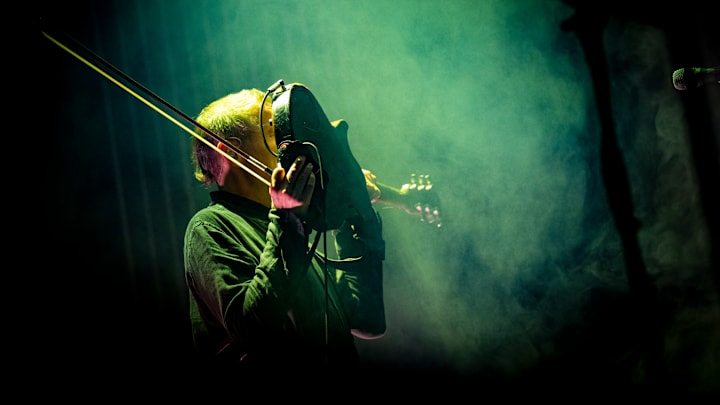The land of fire and ice is one of the least populated countries on Earth, perhaps for good reason. With 10 percent of the nation a literal glacier and thirty active volcanoes dotting the island, the entire country feels like a writhing living being. In other words, fertile ground for exciting and experimental sounds.
You’ve undoubtedly heard of renowned artists like Björk, Sigur Rós, and even Of Monsters and Men, but what about the island’s earlier output? Were Icelandic 80s kids still hip to the music scenes beyond the shores of their island home? You bet your rassinn!
Here are five bands that are as likely to make your head bob as break your tongue trying to pronounce them.
Four 1980s Icelandic bands worth checking out
Fræbbblarnir
Not only is Fræbbblarnir Iceland’s first punk band, but it’s also its oldest. Founded in 1978, the band’s early sound is a unique hybrid of fellow rockers the Clash, with vocals reminiscent of Joy Division’s Ian Curtis. This should come as no surprise, as both influential bands were going strong across the North Atlantic Sea.
The band’s debut, Viltu bjór væna? (literally: Would you like a beer, friend?), is a jovial, packed trip that wears its contemporary influences on its sleeves, i.e., the Clash, and even the Specials with a solid “A Message To You, Rudy” cover.
It’s a killer starting point for the band, especially armed with the knowledge that the entire album is a tongue-in-cheek protest against Iceland’s strict nationwide prohibition policy (bjór = beer).
From 1980 to 1982, Fræbbblarnir released two full-length LPs, an EP, and a couple of singles, were active for five years, and then took a 13-year hiatus. In 1996, partially thanks to a re-issue of Viltu bjór væna?, the band reunited and began churning out more albums from 2000 on. Their latter output has a fuller sound, and the band’s expanded lineup nicely incorporates Iðunn Magnúsdót’s charm into the mix.
Purrkur Pillnikk
On the other side of the spectrum is Purrkur Pillnikk, whose nervy, angular sound was molded by moodier, artsier UK bands, giving it a sharpened new wave edge. Despite being together for an ephemeral 18 months, they were pretty prolific post-punk rockers, pumping out two full LPs, two EPs, and one live album between 1981 and 1982.
They entered the world with EhgjI En, an urgent call to action with 17 jagged tracks filtered through the prism of The Fall and Gang of Four. Googooplex finds the band dabbling in a barrage of new sounds—even abstract clarinet (“Mig langar“)—and tempos, resembling something like The Clash’s London Calling with splashes of The Buzzcocks for good measure.
As was the case in such a tight-knit musical community, Pillnikk’s vocalist Einar Örn would later wind up in other bands, like the three-piece Kukl, which featured a young Björk Guðmundsdottir, who would also join forces with Örn again in the seminal Icelandic band The Sugarcubes.
Utangarðsmenn
Perhaps one of the most revered rock/new wave bands of Iceland’s 80s, Utangarðsmenn was a powerhouse that burned as brightly as the atomic bomb featured on their one and only LP’s cover, Geislavirkir, and was just as explosive.
Lead singer Bubbi Morthens’ leather-jacket swagger and politically tinged lyrics left an indelible mark on the youth of 1980, especially on societal injustices like the plight of migrant workers and the fishing industry.
Politics aside, Geislavirkir is quite possibly this list’s most embraceable album to foreign ears for two reasons:
First, the band’s primary desire to break into the international market prompted the inclusion of English into their lyrics (on tour, they would even change their name to the more pronunciation-friendly “The Outsiders”)
Secondly, it's a gleeful mishmash of familiar genres. Songs oscillate between straight-up rock (“Hiroshima”), blatant reggae (“Kyrrlátt kvöld”, “Viska Einsteins” and the on-the-nose “Chinese reggae”), and Elvis Presley-inspired blues-rock (“Temporary kick / Let's go”).
Þeyr
Just so we’re on the same page, Þeyr is pronounced “They’re” (“Þ” was an early letter that represented the “th” sound), and—a bit anti-climactically—means “They” in Icelandic, but this band is anything but generic.
Þeyr’s 1980 debut Þagað Í Hel is a beautiful and unpredictable beast in the best of ways. At times, singer Magnús Guðmundsson captures the vibrato of 80s contemporaries (“En…”), then jerks the listener sideways to surf-rock complete with “woo-woo”s, complimentary of Elín Reynisdóttir (“Nema Jói”).
However, the most surprising treat the band has to offer is a smattering of tracks that channel the jazz-rock stylings of Steely Dan (“Hringt”, “Svið”), and a Reynisdóttir-centric number that shimmers with 80s opulence (“Eftir Vígið”).
If Þagað Í Hel's genre-ADD seemed unstable, Þeyr’s 1981 sophomore effort, Mjötviður Mær, is a more dependable yet murkier experience, production-wise and melodically. Guðmundsson’s buried vocals—at times completely incoherent—mumble over sinister bass riffs and ominous percussion to a degree that it’s hard to imagine it’s the same band.
With so many new “artists” on Soundcloud, it is a thrilling endeavor to unearth extinct music from a bygone era, but stumbling upon golden nuggets of non-English origin, i.e., Japanese and Icelandic tunes from the '80s, is next-level Indiana Jones.
With no lyrical context, you’re reverted to a child-like sense of discovery, forced to take the sounds drifting into your eardrums at face value, asking hot-blooded questions like, “How does this make me feel?”, while feeling the cold calculating need to inquire, “What does this mean?”.
See the connection here? Fire and ice indeed, Iceland. Skál!
